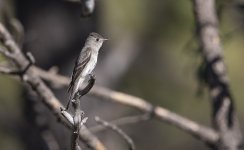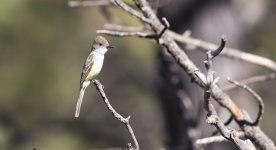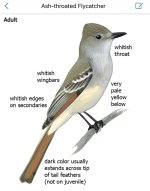-
Welcome to BirdForum, the internet's largest birding community with thousands of members from all over the world. The forums are dedicated to wild birds, birding, binoculars and equipment and all that goes with it.
Please register for an account to take part in the discussions in the forum, post your pictures in the gallery and more.
You are using an out of date browser. It may not display this or other websites correctly.
You should upgrade or use an alternative browser.
You should upgrade or use an alternative browser.
Two flycatchers in Southern Arizona (1 Viewer)
- Thread starter sirijay
- Start date
More options
Who Replied?Harrybongo
Well-known member

Hi. First pic maybe a, Western wood pewee?
Yes: long primary projection, barely visible wing bars. It's a young one as it seems to still have vestiges of an orange gapeA. is a wood-pewee.
Agree.Yes: long primary projection, barely visible wing bars. It's a young one as it seems to still have vestiges of an orange gape
Thanks for all the comments.
Unfortunately, I don't recall the exact location of photo-A. It was a mixed flock of birds in a dry scrubby area. I was leaning toward identifying this bird as a Dusky rather than Ash-throated because it appeared to be somewhat smaller than the Ash-throated and the rufous color was not as strong.
I have a attached a photo of another bird that was also in this flock which I believe is an Ash-throated.
Not sure whether this helps, but thought I'd send it along. Thanks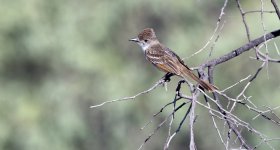
Unfortunately, I don't recall the exact location of photo-A. It was a mixed flock of birds in a dry scrubby area. I was leaning toward identifying this bird as a Dusky rather than Ash-throated because it appeared to be somewhat smaller than the Ash-throated and the rufous color was not as strong.
I have a attached a photo of another bird that was also in this flock which I believe is an Ash-throated.
Not sure whether this helps, but thought I'd send it along. Thanks

tom baxter
Well-known member
1. Is a Western Wood Pewee. As others noted, the overall gray color, lack of eye ring, and very long primary projection are signs that it is a Contopus sp. The all black bill is a significant factor for discounting Greater Pewee, and the bill is not large enough, and the wing bars are too pronounced for Olive-sided Flycatcher.
2. Is definitely Myiarchus sp. In my opinion it’s probably an Ash-throated Flycatcher > Dusky-capped because of the rufous primary shafts, white fringed covert feathers and relatively short looking bill. Perhaps most notably, the outter retrix (tail) feather in the extra photo you provided has a brown rounded off tip that sections off the subterminal orange. This is consistent with one of the better field marks for Ash-throated Flycatcher that is highlighted in my attached photo, screen-shotted from the Sibley field guide app. I think that most of the time adult Dusky-capped will have relatively drab primary shafts, lack boldly white fringed coverts, and have a bill that is noticeably longer, but it is hard to figure out how consistent these patterns are.
In review of the Macaulay Library links below, you will find a mixture of examples of Dusky-capped Flycatchers showing different appearances, presenting a very confusing complex. Many of them do not look like they have a long bill, and have extra rufous coloring on the flight feathers, in direct challenge to my assertions. I think it is very likely that many of these photos in Macaulay Library are misidentified, but of course I don't always know for sure what I am looking at either. A good approach to figuring it out, in my opinion, is to scroll through the photos in the database and look for examples where the best field marks are clearly visible, not obscured at all, and disregard the other non ideal photos where it is more likely that the observer is guessing at the ID. Look for the best photos that show bill length, and flight feather plumage, exactly like your second photo, and look to see if there are any consistencies or not. Taking this filtered approach, I think that you get a lot of examples of Dusky-capped that are pretty easy to immediately notice the long bill and the relative drabness/monochromatic color scheme of the flight feathers. It is not 100% consistent, and there is inherently a lot of ambiguity to identifying Myiarchus sp. which is why you have yet to get a straight forward answer.
Links:
Dusky-capped
Ash-throated
2. Is definitely Myiarchus sp. In my opinion it’s probably an Ash-throated Flycatcher > Dusky-capped because of the rufous primary shafts, white fringed covert feathers and relatively short looking bill. Perhaps most notably, the outter retrix (tail) feather in the extra photo you provided has a brown rounded off tip that sections off the subterminal orange. This is consistent with one of the better field marks for Ash-throated Flycatcher that is highlighted in my attached photo, screen-shotted from the Sibley field guide app. I think that most of the time adult Dusky-capped will have relatively drab primary shafts, lack boldly white fringed coverts, and have a bill that is noticeably longer, but it is hard to figure out how consistent these patterns are.
In review of the Macaulay Library links below, you will find a mixture of examples of Dusky-capped Flycatchers showing different appearances, presenting a very confusing complex. Many of them do not look like they have a long bill, and have extra rufous coloring on the flight feathers, in direct challenge to my assertions. I think it is very likely that many of these photos in Macaulay Library are misidentified, but of course I don't always know for sure what I am looking at either. A good approach to figuring it out, in my opinion, is to scroll through the photos in the database and look for examples where the best field marks are clearly visible, not obscured at all, and disregard the other non ideal photos where it is more likely that the observer is guessing at the ID. Look for the best photos that show bill length, and flight feather plumage, exactly like your second photo, and look to see if there are any consistencies or not. Taking this filtered approach, I think that you get a lot of examples of Dusky-capped that are pretty easy to immediately notice the long bill and the relative drabness/monochromatic color scheme of the flight feathers. It is not 100% consistent, and there is inherently a lot of ambiguity to identifying Myiarchus sp. which is why you have yet to get a straight forward answer.
Links:
Dusky-capped
Ash-throated
Attachments
Last edited:

Tom, he said that the third photo shows a different bird from the second photo. Therefore, they can easily be different species1. Is a Western Wood Pewee. As others noted, the overall gray color, lack of eye ring, and very long primary projection are signs that it is a Contopus sp. The all black bill is a significant factor for discounting Greater Pewee, and the bill is not large enough, and the wing bars are too pronounced for Olive-sided Flycatcher.
2. Is definitely Myiarchus sp. In my opinion it’s probably an Ash-throated Flycatcher > Dusky-capped because of the rufous primary shafts, white fringed covert feathers and relatively short looking bill. Perhaps most notably, the outter retrix (tail) feather in the extra photo you provided has a brown rounded off tip that sections off the subterminal orange. This is consistent with one of the better field marks for Ash-throated Flycatcher that is highlighted in my attached photo, screen-shotted from the Sibley field guide app. I think that most of the time adult Dusky-capped will have relatively drab primary shafts, lack boldly white fringed coverts, and have a bill that is noticeably longer, but it is hard to figure out how consistent these patterns are.
In review of the Macaulay Library links below, you will find a mixture of examples of Dusky-capped Flycatchers showing different appearances, presenting a very confusing complex. Many of them do not look like they have a long bill, and have extra rufous coloring on the flight feathers, in direct challenge to my assertions. I think it is very likely that many of these photos in Macaulay Library are misidentified, but of course I don't always know for sure what I am looking at either. A good approach to figuring it out, in my opinion, is to scroll through the photos in the database and look for examples where the best field marks are clearly visible, not obscured at all, and disregard the other non ideal photos where it is more likely that the observer is guessing at the ID. Look for the best photos that show bill length, and flight feather plumage, exactly like your second photo, and look to see if there are any consistencies or not. Taking this filtered approach, I think that you get a lot of examples of Dusky-capped that are pretty easy to immediately notice the long bill and the relative drabness/monochromatic color scheme of the flight feathers. It is not 100% consistent, and there is inherently a lot of ambiguity to identifying Myiarchus sp. which is why you have yet to get a straight forward answer.
Links:
Dusky-capped
Ash-throated
Niels
tom baxter
Well-known member
Thanks for the clarification. I didnt pay very much attention to the first image, and should have read more carefully on the second one. I get easily distracted by bird pictures lol..... Looking at it again, the first photo appears to lack rufous primary shafts, has a bill that is suggestive of being longer, and has a very thin build overall. I think it is Dusky-capped. Hopefully my long winded, off base comment above contributes something to both ID's.Tom, he said that the third photo shows a different bird from the second photo. Therefore, they can easily be different species
Niels
I'm still not convinced it's a DCFL. Sorry for the shorthand. I prefer to separate them by voice and habitat. I'm in Tucson, and a Myiarchus in a shrubby area nearby is more likely to be ATFL. In Madera Canyon or Florida Canyon and higher elevation? DCFL more likely. I'm not saying it's not a DCFL - it's why Myiarchus are tough without voice and location context. This is my photo of an ATFL taken in a shrubby part of Tucson, FWIW. Different lighting, obviously.
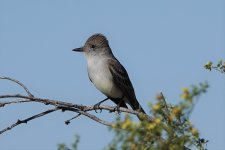

Similar threads
Users who are viewing this thread
Total: 2 (members: 0, guests: 2)




